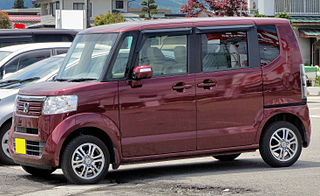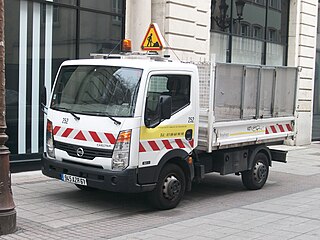
Kei car is the smallest category of Japanese expressway-legal motor vehicles. The term 'Kei' is a shortening of kei-jidōsha,, which translates to English as "light automobile".

The Mazda Bongo, also known as Mazda E-Series, Eunos Cargo, and the Ford Econovan, is a cabover van and pickup truck manufactured by the Japanese automobile manufacturer Mazda since 1966. The Bongo name was also used for the Bongo Friendee, which is not a cabover design.

The Nissan Vanette is a cabover van and pickup truck produced by the Japanese automaker Nissan from 1978 until 2011. The first two generations were engineered by Nissan's Aichi Manufacturing Division for private, personal ownership, with the last two generations built by Mazda, rebadged as Nissans and refocused as commercial vehicles, based on the Mazda Bongo. The van has also been sold as the Nissan Sunny-Vanette or Nissan Van. The private purchase passenger platform was replaced by the Nissan Serena in 1991, renamed Vanette in various international markets, and came equipped with multiple engine and drivetrain configurations.
The Nissan H series of automobile engines is an evolution of the Nissan "R" engine which was based on the 1.5-liter, three-main bearing "G" engine used in the 1960s. Both inline-four and inline-six versions were produced. It is a pushrod OHV design with iron block, early models with an iron head, later models with aluminum head. Versions of this motor have been used in many Nissan autos and forklifts, well into the eighties and a version called H20II was in production until 2003. The SD diesels are based on this series of motors

The Daihatsu Hijet is a cab over microvan and kei truck produced and sold by the Japanese automaker Daihatsu since 1960. Despite the similarities between the Hijet name and Toyota's naming scheme for its trucks and vans, the name "Hijet" has been in use for Daihatsu's kei trucks and microvans since 1960, over two decades before Toyota took control. "Hijet", when transliterated into Japanese, is very similar to "Midget", one of Daihatsu's other mini-trucks. According to Daihatsu, the name "Hijet" was created to imply that the vehicle offers higher performance than the Midget. The Hijet competes in Japan with the Honda Acty, Mitsubishi Minicab, Nissan Clipper, Subaru Sambar and Suzuki Carry.

The Nissan Caravan is a light commercial van designed for use as a fleet vehicle or cargo van and manufactured by Nissan since 1973. Between 1976 and 1997, a rebadged version of the Caravan sold as the Nissan Homy, which was introduced as an independent model in 1965. Outside Japan, the Caravan was also sold as either the Nissan Urvan or Nissan King Van, or earlier with Datsun badging.

The Subaru Sambar is a cabover truck and microvan manufactured and marketed by Subaru as Japan's second truck compliant with the country's strict Keitora (軽トラ) or Kei vehicle tax class, after the Kurogane Baby. Introduced in 1961 in microvan and Kei pickup configurations, the Sambar remains in production, now in its eighth generation — beginning with the sixth generation as a rebadged Daihatsu Hijet.

The Nissan Atlas is a series of pickup trucks and light commercial vehicles manufactured by Nissan. It is built by UD Trucks for the Japanese market, and by the Renault-Nissan Alliance for the European market. The lighter range vehicles, weighing from 1 to 1.5 tons, replaced the earlier Cabstar and Homer (F20), while the heavier Caball and Clipper (C340) were replaced by the 2-to-4 ton range Atlas. The Atlas nameplate was first introduced in December 1981, available at Nissan Bluebird Store locations.
The Mitsubishi Town Box is a kei car and minivan produced for the Japanese domestic market (JDM) by the Japanese automaker Mitsubishi Motors. It was initially available with the alloy-headed 4A30 657 cc inline-four engine, but switched to the 3G83 659 cc straight-three engine in 2002. From June 1999 until August 2001, a slightly larger version of the same vehicle powered by a 4A31 1.1 L straight-four, the Mitsubishi Town Box Wide, was also available. The first generation Town Box was discontinued in November 2011, ending the twelve-year production run. The nameplate returned in February 2014 on a rebadged version of the Suzuki Every Wagon.

The Mitsubishi Minicab is a kei truck and microvan, built and sold in Japan by Japanese automaker Mitsubishi Motors since 1966. In Japan, it was sold at a specific retail chain called Galant Shop. It was also sold by China Motor Corporation (CMC) in Taiwan as the CMC Veryca, starting in 1985. A battery electric model of the Minicab, called the Minicab MiEV, is sold in the Japanese market since December 2011.

The Suzuki Carry is a kei truck produced by the Japanese automaker Suzuki. The microvan version was originally called the Carry van until 1982 when the passenger van versions were renamed as the Suzuki Every. In Japan, the Carry and Every are kei cars but the Suzuki Every Plus, the bigger version of Every, had a longer bonnet for safety purposes and a larger engine; export market versions and derivatives have been fitted with engines of up to 1.6 liters displacement. They have been sold under myriad different names in several countries, and is the only car to have been offered with Chevrolet as well as Ford badges.

A microvan is a van or minivan which is within the Japanese kei car classification or similar, and is smaller than a mini MPV. In China, these vehicles are nicknamed miàn bāo chē because of their shape. Similarly, in several Hispanic American countries, these vehicles are called pan de molde, which means "bread loaf". In Indonesia, it is commonly called a minibus due to their tall roof, perceived as resembling a miniature bus; the term is also used generally to refer to any type of three-row MPVs.

Nissan Cabstar is the name used in Japan for two lines of pickup trucks and light commercial vehicles sold by Nissan and built by UD Nissan Diesel, a Volvo AB company and by Renault-Nissan Alliance for the European market. The name originated with the 1968 Datsun Cabstar, but this was gradually changed over to "Nissan" badging in the early 1980s. The lighter range replaced the earlier Cabstar and Homer, while the heavier Caball and Clipper were replaced by the 2-4 ton range Atlas (kana:日産・アトラス). The nameplate was first introduced in December 1981.The Cabstar is known also as the Nissan Cabstar, Renault Maxity and Samsung SV110 depending on the location. The range has been sold around the world. It shares its platform with the Nissan Caravan. In spring 2014, Cabstar is now known as NT400.

The Wuling Dragon was a series of cabover microvans and kei trucks made by SAIC-GM-Wuling Automobile, the Chinese joint venture with General Motors of the United States of America. The Dragon is the successor of the earlier Liuzhou Wuling LZ110, which was based on the 1977-1984 Mitsubishi Minicab.

The ME21/24 engine was Shin Mitsubishi Heavy-Industries' replacement for the 309 cc single-cylinder overhead valve ME20 engine. Unlike its predecessor, this was a two-stroke, a concept to which Mitsubishi was to prove faithful for its smallest engines until the 1972 introduction of the Vulcan 2G21.

The Nissan Caball is a light commercial truck manufactured by Nissan Motors from December 1957 until December 1981. The Caball was mainly sold in Japan, Hong Kong, South East Asian countries, Australia, New Zealand, and few European countries and shared the Nissan Junior platform. While the Caball name came to an end in 1981 with the cancellation of the Junior, its larger replacement received the Nissan Atlas name in the domestic Japanese market. These are 2–4 ton trucks, the lighter versions in the Atlas truck range took over after the lesser Cabstar/Homer. In Japan, it was available at Nissan Store locations and replaced by the Nissan Atlas.

Wuling Motor Holdings., Ltd, is a Chinese manufacturer of automobiles, subsidiary of Guangxi Automotive Group.
The Suzuki R engine is an inline-three engine that has been produced by Suzuki since 2011. Initially introduced in the third-generation MR Wagon, and intended as a replacement for the K6A engine, the R engine has since been used in various Suzuki's, such as the Alto, the Wagon R, and the Carry.

The CMC Veryca (中華菱利) or CMC Varica (中華百利/中華威利) is a cabover kei truck and microvan built and sold in Taiwan by the Taiwanese automaker China Motor Corporation (CMC) (中華汽車) since 1985, with its predecessor entering production in 1978.


























